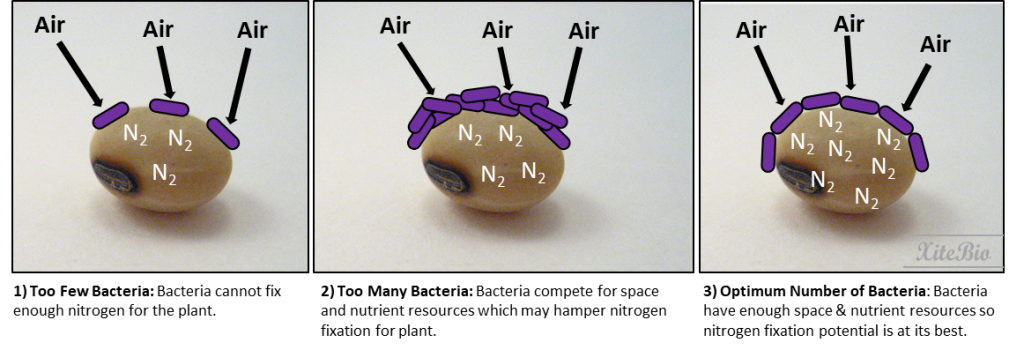When it comes to inoculants, not all are created equal, and there is no end to the variation you can find between products. One of the key differences between different brands and products is the colony forming unit (CFU)/ml or g, or more plainly, the actual number of bacteria within the product. An inoculant that boasts a higher CFU/ml will have more bacterial colonies in it, and therefore provide more bacteria to your soil. So the question comes to mind: is more always better?
The simple answer is no.
More bacterial colonies per unit of product is not always beneficial, and can often be harmful to your crop’s ability for nitrogen fixation. For every inoculated crop there is an optimum number of nitrogen-fixing bacteria to have in the surrounding root soil, or rhizosphere, that will lead to maximum nodulation. Going beyond this number can lead to the bacteria introduced by your inoculant competing with your native soil bacteria for resources such as space on your seed surface or nutrient resources or substrates. Life in the rhizosphere is incredibly competitive, and if your bacteria have to spend time and energy competing with each other then they are not colonizing or infecting roots and forming active nodules.

In situations where a field has no native population or a smaller native population of nitrogen fixing bacteria, a larger proportion of bacteria must be introduced through an inoculant. For example, when planting soybeans on land that has not previously had a soybean crop on it, you will need an extra boost of inoculant. The bacteria that forms nodules with soybean roots, Bradyrhizobium japonicum, is not native to North American soil, and a virgin soybean field will have no population of these rhizobacteria in its soil, requiring extra inoculation. That’s why dual inoculation is often suggested in virgin lands. A field that has a history of soybeans will have a native population of B. japonicum from previous inoculations, and will require less inoculation as a result.
What you should look for is an inoculant that can provide consistent agronomic results while providing an optimum number of healthy, robust bacteria to your soil without adding too much to cause resource competition. This will lead to your plant roots reaching their maximum potential for nodule formation, thereby maximizing their nitrogen fixation potential. In short, don’t believe the hype when it comes to putting the largest amount of bacteria into your soil, and always follow your inoculant manufacturer’s application guidelines to prevent applying too much or too little.

